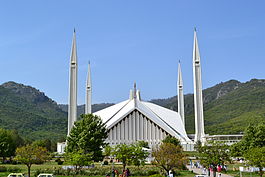Faisal Mosque
The Faisal Mosque is the largest mosque in Pakistan, located in the national capital city of Islamabad. Completed in 1986, it was designed by Turkish architect Vedat Dalokay to be shaped like a desert Bedouin's tent.It is situated at the north end of Faisal Avenue, putting it at the northernmost end of the city and at the foot of Margalla Hills, the westernmost foothills of the Himalayas. It is located on an elevated area of land against a picturesque backdrop of the Margalla Hills. This enviable location represents the mosque's great importance and allows it to be seen from miles around day and night.
The Faisal Mosque is conceived as the National Mosque of Pakistan and named after the late King Faisal bin Abdul-Aziz of Saudi Arabia, who supported and financed the project.
The largest mosque in South Asia, the Faisal Mosque was the largest mosque in the world from 1986 until 1993, when it was overtaken in size by the newly completed Hassan II Mosque in Casablanca, Morocco. Subsequent expansions of the Masjid al-Haram (Grand Mosque) of Mecca and the Al-Masjid al-Nabawi (Prophet's Mosque) in Medina, Saudi Arabia, during the 1990s relegated Faisal Mosque to fourth place in terms of size.

History:
The impetus for the mosque began in 1966 when the late King Faisal bin Abdul-Aziz supported the initiative of the Pakistani Government to build a national mosque in Islamabad during an official visit to Pakistan.In 1969, an international competition was held in which architects from 17 countries submitted 43 proposals. The mosque was designed by Turkish architect Vedat Dalokay. Construction of the mosque began in 1976 by National Construction of Pakistan, led by Azim Khan and was funded by the government of Saudi Arabia, at a cost of over 130 million Saudi riyals (approximately 120 million USD today). King Faisal bin Abdul Aziz was instrumental in the funding, and both the mosque and the road leading to it were named after him after his assassination in 1975. The mosque was completed in 1986, and used to house the International Islamic University.
Many conservative Muslims criticised the design at first for its unconventional design and lack of a traditional dome structure, but most criticism ended when the completed mosque's scale, form, and setting against the Margalla Hills became evident.
CREATE AN ACCOUNT AND LEARN MORE :
http://getstartedonline.net/?vip=3571
No comments:
Post a Comment